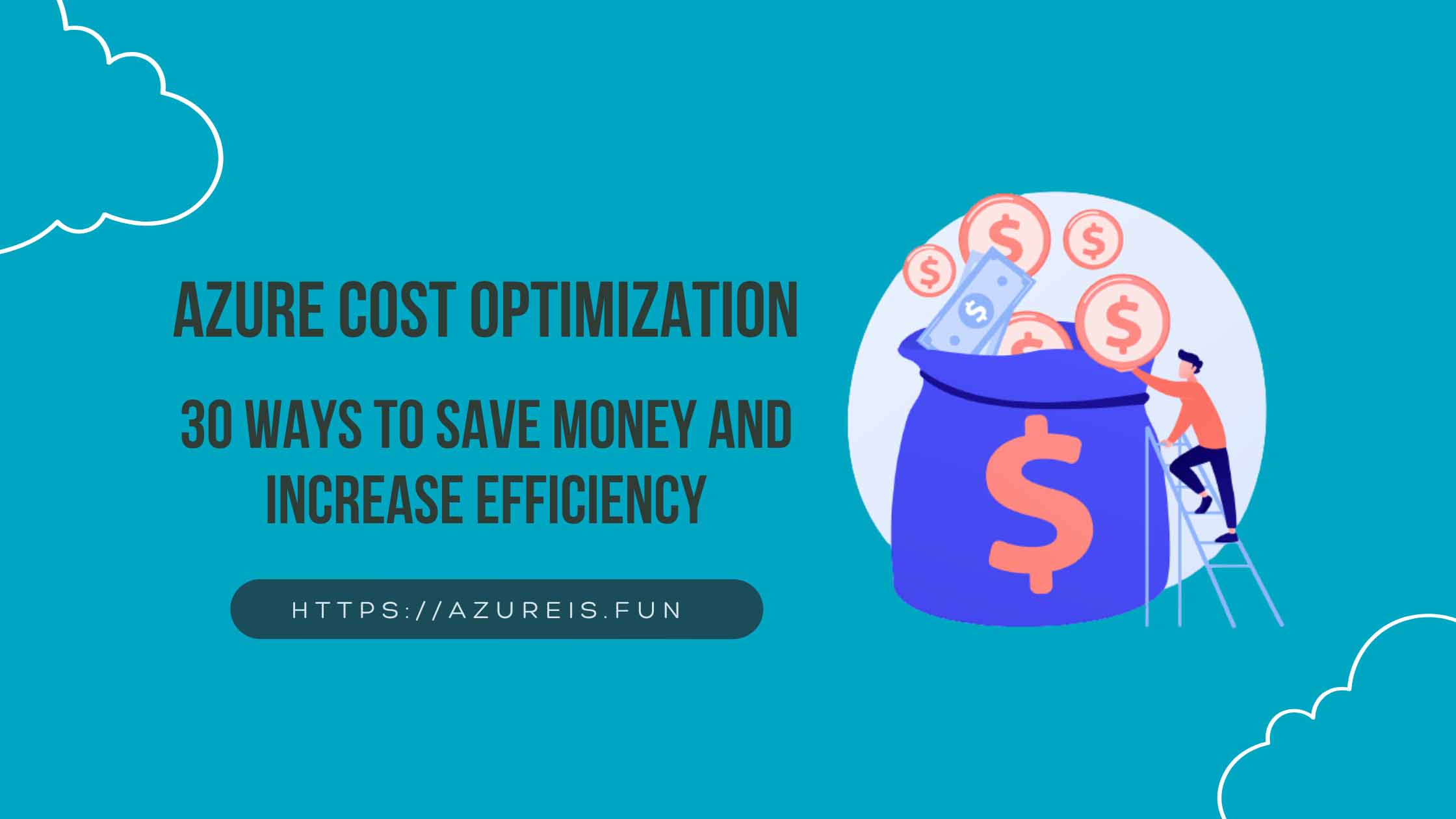
As organizations continue to migrate their applications and workloads to the cloud, managing and controlling cloud costs has become an increasingly critical issue. While Azure provides a robust set of cost management tools and features, identifying the most effective ways to reduce Azure costs can still be challenging. In this article, we’ll explore 30 top ways to reduce Azure costs, ranging from fundamental best practices to advanced techniques that can help you optimize your spending and get the most out of your cloud investments.
1. Right-sizing Azure resources
Analyze the utilization and performance metrics of your resources and optimize their size and configuration to minimize costs while meeting performance requirements.
2. Azure Advisor
Utilize Azure Advisor to get recommendations for optimizing your resource utilization, reducing costs and improving performance.
3. Azure Cost Management
Use Azure Cost Management to gain insights into your Azure spending and identify opportunities to reduce costs. Use Budgets and Alerts to set spending thresholds and receive notifications when costs exceed those thresholds.
4. Azure Policy
Azure Policy can help prevent overspending in Azure by enforcing rules that ensure resources are deployed in accordance with organizational policies, budgets, and compliance requirements, thereby reducing the risk of cost overruns and financial waste.
Check out this article I wrote about Azure Policy: Azure Policy ideas for Azure Governance
5. Auto-Shutdown for VMs
Use Azure Auto-Shutdown to automatically shut down virtual machines during off-hours to reduce unnecessary costs.
I wrote more about that topic in this article: Automate Azure VM Start-Stop with Azure Automation and Tags
6. Azure Hybrid Benefit
Use Azure Hybrid Benefits to save up to 40% on virtual machine costs by utilizing existing Windows Server or SQL Server licenses.
7. Azure Reserved Instances
Use Azure Reserved Instances to save cost on virtual machine, SQL and Cosmos DBs, App service, AKS, Databrics, storage and Azure Virtual Desktops. Committing to one- or three-year terms can significantly reduce costs.
8. Azure Savings Plan
Azure Savings Plan is a flexible discount program that helps reduce costs by allowing you to commit to a consistent usage amount for one or three years in exchange for discounted rates on your Azure usage, providing predictable pricing and reducing overall cloud spend.
9. Azure Spot VMs
Use Azure Spot VMs to save on virtual machine costs by utilizing spare capacity in Azure datacenters.
10. Use Azure Platform Services instead of VMs
Use Azure Cloud Services to simplify the deployment and management of scalable applications and reduce the costs associated with maintaining infrastructure. Utilize Azure Serverless Computing and containers to pay only for the actual usage of your functions, avoiding the cost of idle resources. Keep optimizing your environment after initial migration/setup and keep improving it.
11. Remove unused and orphaned resources
Effective way to reduce Azure costs is to regularly clean up unused resources and resource groups. Use Azure Graph Explorer runbooks to help you monitoring for orphaned and unused resources..
Here is another blog post that can help you with that: Keeping Your Azure Environment Clean with Automation
12. Azure Marketplace Offerings
Utilize pre-built solutions from the Azure Marketplace to reduce development costs and accelerate time-to-market.
13. Azure Virtual Machine Scale Sets
Use Azure Virtual Machine Scale Sets to scale up or down virtual machines based on demand, reducing the need for overprovisioning and reducing costs.
14. Infrastructure as a Code
Using IaaC in Azure can help reduce costs by automating the deployment and management of cloud resources, improving efficiency, reducing the risk of errors, and enabling easier optimization of resource utilization.
15. Azure SQL Database Elastic Pools
Use Azure SQL Database Elastic Pools to reduce the cost of running multiple databases by sharing resources across multiple databases.
16. Azure Cosmos DB Multi-Master Replication
Use Azure Cosmos DB Multi-Master Replication to reduce the latency and cost associated with replicating data across multiple regions.
17. Use licenses for non-profit organizations
Utilize licenses for schools and non-profit organizations if you are eligible, they are less expensive.
18. Use Azure Storage Lifecycle Management
Use Azure Storage Lifecycle Management to automatically move data to lower-cost storage tiers, reducing the costs associated with storing large amounts of data.
19. Use correct tiers for Azure Storage Accounts
Use Azure Storage Account Hot Access Tier to reduce storage costs by storing frequently accessed data in a lower-cost tier. And use Archive tier for data that is just sitting there and it is not being accessed (up to 72%!)
20. Use Azure Dev/Test pricing and Free Services
Utilize Azure Dev/Test pricing to save on virtual machine costs by utilizing reduced pricing for non-production workloads. Azure also offers a large number of services that are always free.
21. Azure Service Bus
Use Azure Service Bus to decouple applications and reduce the costs associated with maintaining infrastructure.
22. Azure Event Grid
Use Azure Event Grid to reduce the cost of messaging by only paying for the events you consume.
23. Azure Batch
Use Azure Batch to run large-scale parallel and high-performance computing workloads, reducing the costs associated with managing infrastructure.
24. Azure Cache for Redis
Utilize Azure Cache for Redis to reduce the cost of expensive database operations by caching frequently accessed data.
25. Azure API Management
Azure API Management can help you manage and secure your APIs, reducing the costs associated with building and maintaining custom APIs.
25. Azure Virtual Desktop
Start using Azure Virtual Desktop instead of provisioning individual VMs with Client OS (Windows 10,11) for your users, or using large numbre of expensive Windows 365 Licenses.
26. Use single Azure Bastion
Azure Bastion works accross multiple peered networks and subscriptions and it is not always necessary to provision multiple instances.
27. Azure ExpressRoute
Azure ExpressRoute can be expensive, but using it to connect your on-premises infrastructure directly to Azure will eliminate the need for for expensive internet bandwidth and it can end up being a cheaper and more reliable solution.
28. Azure Data Factory Data Flow Debugging
Azure Data Factory Data Flow Debugging can help you avoid expensive debugging costs by debugging in the development environment.
29. Implement auto-scaling where possible
By implementing auto-scaling, you can automatically adjust the amount of resources allocated to an application based on demand. Use it in combination with Azure Load Balancer to distribute incoming traffic across multiple virtual machines, so you don’t need to overprovision single VM to handle all the work.
30. Make your environment secure and highly available
To finish this list, here is another obvious task. Making your environment highly available and secure can significantly reduce the cost that can ocure in case of a disaster or a security breach. Utilize services such as Azure Security Center, Backups, Site Recovery, Network watcher, Azure Sentinel, access reviews, etc.
Do you use all of these ways to save the cost?
Vukasin Terzic
